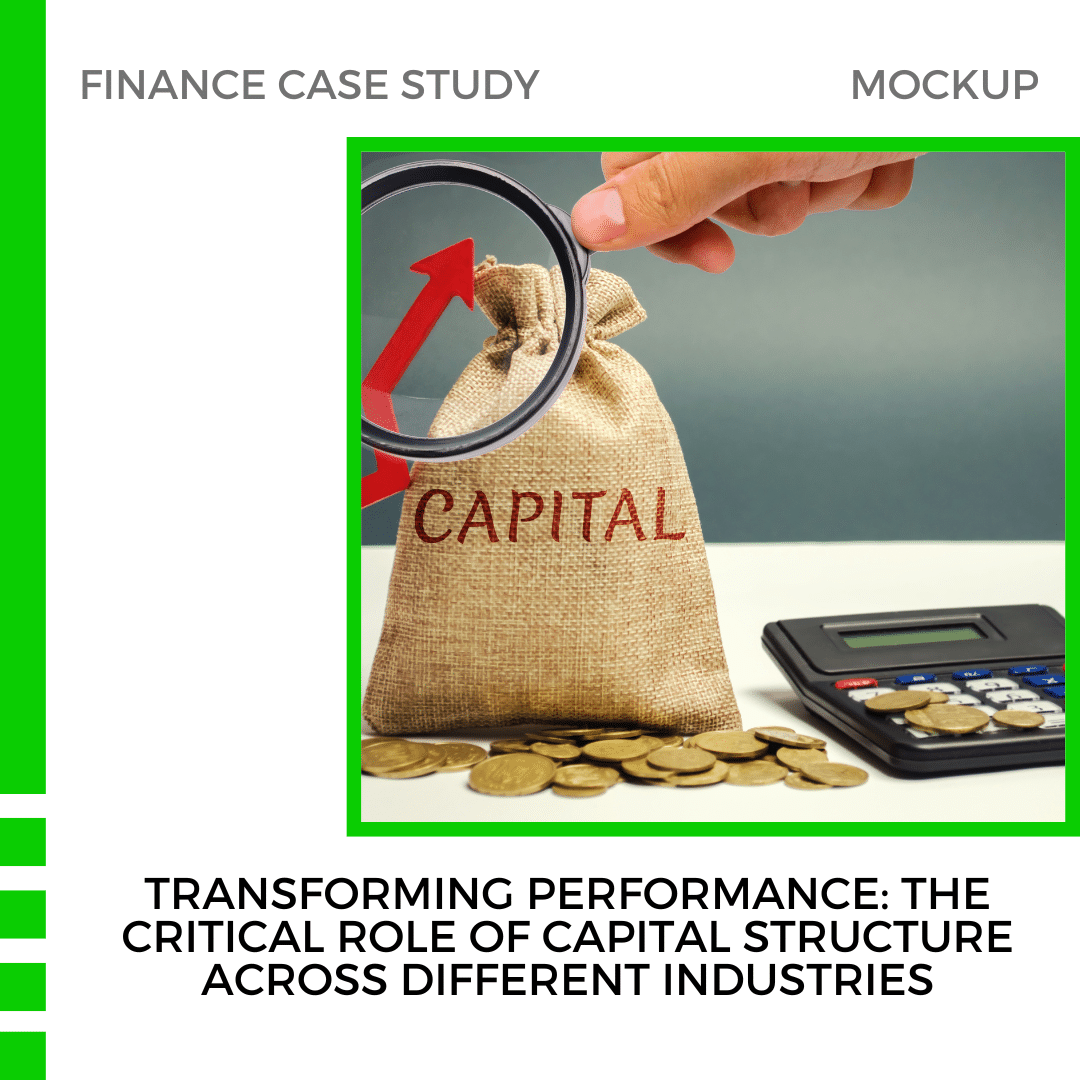
Transforming Performance: The Critical Role of Capital Structure Across Different Industries
Introduction
Capital structure refers to the blend of debt and equity a firm uses to fund its operations and facilitate growth. Understanding how capital structure affects firm performance is vital for stakeholders, especially in industries with differing characteristics. This case study examines the capital structures of representative companies in the Technology, Manufacturing, and Retail sectors. Students will analyze and evaluate financial performance and discuss the implications of varying capital structures across these industries.
Objectives
- Understand the concept of capital structure and its components.
- Analyze the capital structure of firms in different industries.
- Evaluate the impact on firm performance.
- Discuss the advantages and disadvantages of different capital structures.
Background Information
Capital Structure Components
- Debt: This includes loans and other borrowed capital the firm must repay with interest.
- Equity is the capital invested by the firm’s owners through issuing shares.
Key Financial Metrics
- Debt-to-Equity Ratio (D/E): This measures a firm’s leverage and is calculated by dividing total debt by equity.
- Return on Equity (ROE) measures a firm’s profitability and is calculated as net income divided by shareholders’ equity.
- Earnings Before Interest and Taxes (EBIT) measures a firm’s operating performance.
Industry Analysis
Industry 1: Technology
Company A: Tech Innovations Inc.
- Capital Structure:
- Total Debt: $500 million
- Total Equity: $1,500 million
- D/E Ratio: 0.33
- Performance Metrics:
- EBIT: $300 million
- ROE: 15%
Characteristics of the Technology Industry:
- High growth potential.
- Significant R&D expenditures.
- Typically, lower reliance on debt due to high profitability and optimistic growth expectations.
Industry 2: Manufacturing
Company B: Global Manufacturing Ltd.
- Capital Structure:
- Total Debt: $800 million
- Total Equity: $800 million
- D/E Ratio: 1.0
- Performance Metrics:
- EBIT: $200 million
- ROE: 10%
Characteristics of the Manufacturing Industry:
- Capital-intensive operations.
- Moderate growth potential.
- Balanced use of debt and equity to finance large-scale production and equipment.
Industry 3: Retail
Company C: Retail Giants Corp.
- Capital Structure:
- Total Debt: $1,200 million
- Total Equity: $600 million
- D/E Ratio: 2.0
- Performance Metrics:
- EBIT: $150 million
- ROE: 20%
Characteristics of the Retail Industry:
- High inventory and working capital requirements.
- A competitive market characterized by thin margins.
- Higher reliance on debt to finance inventory and expansion.
Case Study Analysis
Task 1: Analyze Capital Structures
Compare the Capital Structures:
- Tech Innovations Inc. (D/E Ratio: 0.33) exhibits a conservative approach to debt, minimizing financial risk while aiming for growth.
- Global Manufacturing Ltd. (D/E Ratio: 1.0) reflects a balanced capital structure, supporting operational stability.
- Retail Giants Corp. (D/E Ratio: 2.0) showcases high leverage, indicating aggressive financing to seize growth opportunities, but it also elevates financial risk.
Implications of D/E Ratios:
- Lower D/E ratios (like that of Tech Innovations) correlate with reduced financial risk, whereas higher D/E ratios (such as Retail Giants) can lead to greater returns but also increase bankruptcy risk.
Task 2: Evaluate Financial Performance
Assess ROE and EBIT:
- Tech Innovations Inc.:
- ROE: 15%
- EBIT: $300 million
- Global Manufacturing Ltd.:
- ROE: 10%
- EBIT: $200 million
- Retail Giants Corp.:
- ROE: 20%
- EBIT: $150 million
Analysis of Capital Structure Impact:
- Tech Innovations demonstrates solid profitability with lower leverage, while Retail Giants Corp. achieves a high ROE but faces risks from elevated debt levels. Global Manufacturing finds a middle ground, effectively balancing risk and return.
Task 3: Discuss Advantages and Disadvantages
Debt Financing:
- Advantages:
- Tax benefits from interest payments.
- Leverage effects can enhance ROE.
- Disadvantages:
- Financial risks due to fixed interest obligations.
- Increased potential for bankruptcy if debt obligations are unmet.
Equity Financing:
- Advantages:
- There is no obligation to repay, resulting in lower financial risk.
- Disadvantages:
- Dilution of ownership among shareholders.
- It may have a higher cost of capital compared to debt financing.
Task 4: Industry-Specific Considerations
Technology Industry:
- Companies in this sector may favour lower debt levels due to the significant capital required for R&D and the volatile nature of technology markets. A lower capital structure with less debt allows flexibility to invest in innovation.
Manufacturing Industry:
- A balanced capital structure is essential in manufacturing, where stable cash flows support financing decisions. Asset-heavy operations often necessitate careful consideration of the debt-equity mix.
Retail Industry:
- The high debt levels in the retail sector reflect the need to finance inventory and expansion in a competitive landscape. However, this reliance on debt increases vulnerability to economic fluctuations and changing consumer behaviours.
Possible Solution
Firms should adopt a flexible financing strategy to optimise their capital, considering industry-specific factors and economic conditions. For example, technology firms could maintain low debt levels to ensure sufficient cash flow for R&D. In contrast, manufacturing firms may benefit from a balanced approach that includes debt and equity to support long-term investments. Retailers should carefully manage their debt to ensure they can meet inventory demands without over-leveraging themselves.
Conclusion
This case study emphasizes the crucial role of capital structure in shaping firm performance across various industries. Each sector presents unique characteristics influencing the decisions, such as growth potential, operational requirements, and market conditions.
References
- Investopedia – Capital Structure
- Harvard Business Review – The Cost of Debt
- Financial Times – Understanding Capital Structure
This structured analysis thoroughly explains how capital structure influences firm performance, aiding students in their financial studies.
Explore Business Models of Global Companies and Indian Companies



